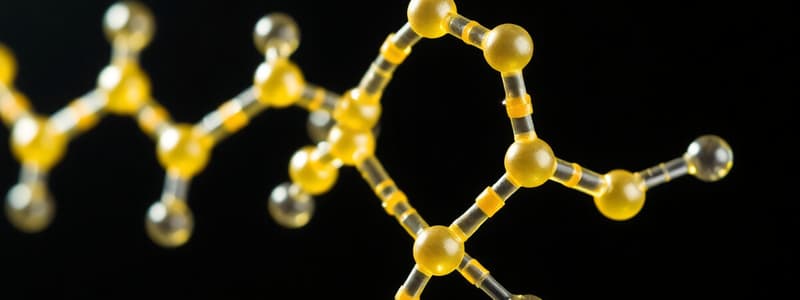Podcast
Questions and Answers
What distinguishes mesophiles from other types of microbes in terms of temperature preference?
What distinguishes mesophiles from other types of microbes in terms of temperature preference?
- They thrive at temperatures below freezing.
- They grow at human body temperature. (correct)
- They require very high temperatures for growth.
- They are unable to grow outside of cold environments.
How does Helicobacter pylori manage to survive in the acidic environment of the stomach?
How does Helicobacter pylori manage to survive in the acidic environment of the stomach?
- It produces urease to neutralize acidity. (correct)
- It secretes mucous to coat itself.
- It absorbs and pumps out the acidic content.
- It produces a protective biofilm.
What is the primary difference between complex and synthetic media in microbiology?
What is the primary difference between complex and synthetic media in microbiology?
- Synthetic media has an unknown composition of nutrients, while complex media has a defined chemical structure.
- Complex media is composed of a known mixture, while synthetic media has known components. (correct)
- Complex media comprises organic components, whereas synthetic media includes only inorganic nutrients.
- Synthetic media is undefined while complex media is defined.
In the context of Frederick Griffith's experiments, what did the observation of the transformation principle confirm?
In the context of Frederick Griffith's experiments, what did the observation of the transformation principle confirm?
What was the significant finding from the experiments conducted by Oswald Avery and his colleagues regarding genetic material?
What was the significant finding from the experiments conducted by Oswald Avery and his colleagues regarding genetic material?
What are the primary roles of DNA in cellular functions?
What are the primary roles of DNA in cellular functions?
What key difference exists between polycistronic and monocistronic mRNA?
What key difference exists between polycistronic and monocistronic mRNA?
What is the function of the Shine-Dalgarno sequence in prokaryotic mRNA?
What is the function of the Shine-Dalgarno sequence in prokaryotic mRNA?
What is the result of a nonsense mutation in a gene?
What is the result of a nonsense mutation in a gene?
Which of the following characteristics of eukaryotic transcription differs from that of prokaryotic transcription?
Which of the following characteristics of eukaryotic transcription differs from that of prokaryotic transcription?
What is the primary mechanism by which transformation occurs in bacteria?
What is the primary mechanism by which transformation occurs in bacteria?
Which of the following correctly describes the lytic cycle of bacteriophage replication?
Which of the following correctly describes the lytic cycle of bacteriophage replication?
What is the role of restriction endonucleases in genetic engineering?
What is the role of restriction endonucleases in genetic engineering?
Which statement distinguishes Hfr cells from F+ and F- cells?
Which statement distinguishes Hfr cells from F+ and F- cells?
What is generation time in bacterial growth?
What is generation time in bacterial growth?
What occurs during nucleotide excision repair?
What occurs during nucleotide excision repair?
In blue-white screening, what color will colonies containing recombinant plasmids appear?
In blue-white screening, what color will colonies containing recombinant plasmids appear?
Which stage of the bacterial growth curve is characterized by a plateau in the number of living bacterial cells?
Which stage of the bacterial growth curve is characterized by a plateau in the number of living bacterial cells?
Which of the following accurately describes specialized transduction?
Which of the following accurately describes specialized transduction?
During which phase of bacterial growth would symptoms of disease typically develop?
During which phase of bacterial growth would symptoms of disease typically develop?
What does competence refer to in bacterial cells?
What does competence refer to in bacterial cells?
What is the primary purpose of the streak plate method in microbiology?
What is the primary purpose of the streak plate method in microbiology?
What does it mean for an organism to be classified as VBNC?
What does it mean for an organism to be classified as VBNC?
What is the function of a repressor protein in an operon?
What is the function of a repressor protein in an operon?
Which of the following statements is true regarding vertical gene transfer?
Which of the following statements is true regarding vertical gene transfer?
Which organisms are capable of undergoing aerobic respiration?
Which organisms are capable of undergoing aerobic respiration?
What is the primary function of the Gaspak system in microbiological studies?
What is the primary function of the Gaspak system in microbiological studies?
Which of the following pH classifications refer to organisms that thrive in acidic conditions?
Which of the following pH classifications refer to organisms that thrive in acidic conditions?
At what temperature range do mesophiles grow best?
At what temperature range do mesophiles grow best?
What role does the catalase test serve in microbiology?
What role does the catalase test serve in microbiology?
Flashcards are hidden until you start studying
Study Notes
Restriction Endonucleases
- Enzymes that cut DNA at specific nucleotide sequences, called restriction sites
- Recognize palindromic sequences
- Make cuts, either blunt or sticky ends
Competence
- Ability of a cell to take up extracellular DNA from its environment during transformation.
Ways to achieve competence
- Natural competence: Some bacteria naturally take up DNA under certain conditions
- Chemical competence: Cells are treated with calcium chloride to increase membrane permeability
- Electroporation: An electric field is applied to create temporary pores in the cell membrane, allowing DNA to enter
- Heat shock: Cells are exposed to a sudden increase in temperature, creating membrane pores for DNA uptake
Molecular Cloning Steps
- Isolation of the DNA of interest: The gene to be cloned is cut using restriction enzymes.
- Insertion into a vector: The isolated DNA is ligated (joined) into a cloning vector (e.g., plasmid).
- Transformation into a host cell: The recombinant vector is introduced into a competent host cell, usually bacteria.
- Selection of recombinant cells: Cells that have successfully taken up the recombinant DNA are selected using antibiotic resistance or reporter genes.
Blue-White Screening
- Technique used to differentiate between bacterial colonies that contain recombinant plasmids and those that do not.
- Bacteria with non-recombinant plasmids produce a blue color (due to β-galactosidase activity).
- Bacteria with recombinant plasmids (insertion of foreign DNA disrupts the lacZ gene) produce white colonies, indicating successful cloning.
Studying That Suits You
Use AI to generate personalized quizzes and flashcards to suit your learning preferences.



